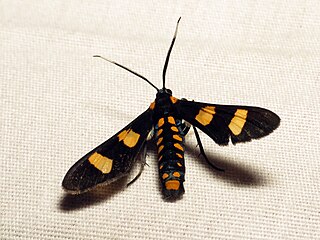
Lepidoptera is an order of insects that includes butterflies and moths. About 180,000 species of the Lepidoptera are described, in 126 families and 46 superfamilies, 10 percent of the total described species of living organisms. It is one of the most widespread and widely recognizable insect orders in the world. The Lepidoptera show many variations of the basic body structure that have evolved to gain advantages in lifestyle and distribution. Recent estimates suggest the order may have more species than earlier thought, and is among the four most speciose orders, along with the Hymenoptera, Diptera, and Coleoptera.

Moths are a paraphyletic group of insects that includes all members of the order Lepidoptera that are not butterflies, with moths making up the vast majority of the order. There are thought to be approximately 160,000 species of moth, many of which have yet to be described. Most species of moth are nocturnal, but there are also crepuscular and diurnal species.

The Sphingidae are a family of moths (Lepidoptera) called sphinx moths, also colloquially known as hawk moths, with many of their caterpillars known as “hornworms”; it includes about 1,450 species. It is best represented in the tropics, but species are found in every region. They are moderate to large in size and are distinguished among moths for their agile and sustained flying ability, similar enough to that of hummingbirds as to be reliably mistaken for them. Their narrow wings and streamlined abdomens are adaptations for rapid flight. The family was named by French zoologist Pierre André Latreille in 1802.
Mallodeta is a monotypic moth genus in the family Erebidae described by Arthur Gardiner Butler in 1876. Its single species, Mallodeta clavata, was described by Francis Walker in 1854. It is found in Brazil and Paraguay.

Phoenicoprocta is a genus of tiger moths in the family Erebidae. The genus was erected by Herbert Druce in 1898.

The Erebidae are a family of moths in the superfamily Noctuoidea. The family is among the largest families of moths by species count and contains a wide variety of well-known macromoth groups. The family includes the underwings (Catocala); litter moths (Herminiinae); tiger, lichen, and wasp moths (Arctiinae); tussock moths (Lymantriinae), including the arctic woolly bear moth ; piercing moths ; micronoctuoid moths (Micronoctuini); snout moths (Hypeninae); and zales, though many of these common names can also refer to moths outside the Erebidae. Some of the erebid moths are called owlets.
Phoenicoprocta capistrata is a moth in the subfamily Arctiinae. The species was first described by Johan Christian Fabricius in 1775. It is found in the Caribbean and Brazil.
Phoenicoprocta partheni is a moth of the subfamily Arctiinae. It was described by Johan Christian Fabricius in 1793. It is found on Haiti.
Phoenicoprocta analis is a moth in the subfamily Arctiinae. It was described by Curt Schrottky in 1909. It is found in Paraguay.
Phoenicoprocta haemorrhoidalis is a moth in the subfamily Arctiinae. It was described by Johan Christian Fabricius in 1775. It is found in Brazil.

Phoenicoprocta hampsonii is a moth in the subfamily Arctiinae. It was described by William Barnes in 1904. It is found in the United States in south-eastern Arizona and in Mexico's Baja California.
Phoenicoprocta lydia, the Lydia tiger moth, is a moth in the subfamily Arctiinae. It was described by Herbert Druce in 1889. It is found in Mexico and southern Texas.
Phoenicoprocta rubiventer is a moth in the subfamily Arctiinae. It was described by George Hampson in 1898. It is found in Panama.
Phoenicoprocta sanguinea is a moth in the subfamily Arctiinae. It was described by Francis Walker in 1854. It is found in Honduras.
Phoenicoprocta teda is a moth in the subfamily Arctiinae. It was described by Francis Walker in 1854. It is found in Santa Catarina, Brazil.
Phoenicoprocta thera is a moth in the subfamily Arctiinae. It was described by Herbert Druce in 1889. It is found in Mexico.

Phoenicoprocta paucipuncta is a moth in the subfamily Arctiinae. It was described by Harrison Gray Dyar Jr. in 1914. It is found in Panama.
Phoenicoprocta jamaicensis is a moth in the subfamily Arctiinae. It was described by Schaus in 1901. It is found on Jamaica.
The Euchromiina are a subtribe of tiger moths in the family Erebidae. It was described by Arthur Gardiner Butler in 1876. Many species in the subtribe are mimics of wasps.





